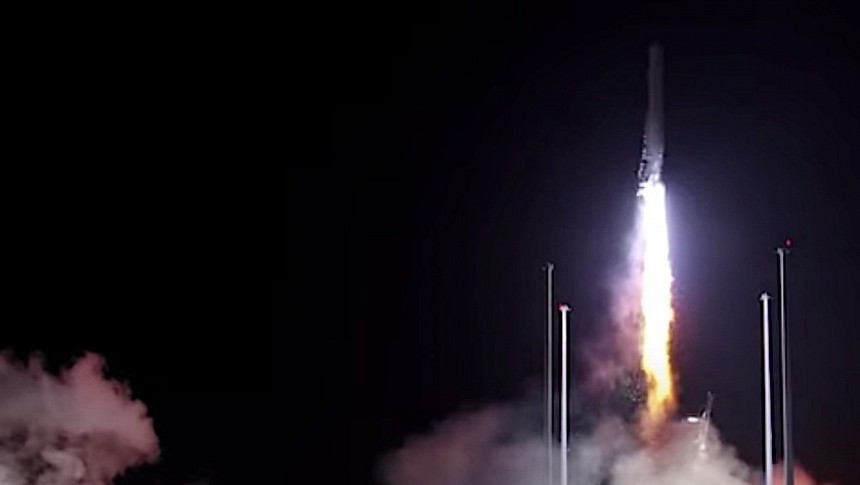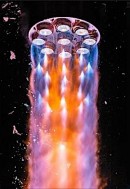We average Joes might bask in the knowledge that our species is fairly advanced from a technological standpoint, and more than able to study the space surrounding our planet. But engineers working in the space industry know that's far from being true, and they keep working around the clock to come up with the technologies that will really open up the skies for us.
This story, however, is not about technology per se, but about an important constituent that goes into one. It's about a new type of copper alloy that was recently tested and proved to have properties that just might give rocket engines a lot more capabilities.
Back in March 2023, a space startup called Relativity Space launched from Cape Canaveral Space Force Station in Florida a rocket called Terran 1. By all accounts, it was the world's first (almost) fully 3D-printed rocket, with many of its components produced this way.
100 feet tall and 7.5 feet wide (30 and 2.2 meters), the rocket itself looked like any other machine of its kind. It also failed like many others of its kind, not managing to enter the second stage of its flight.
Yet it flew, proving to the world that even a piece of hardware that is made 85 percent by mass using 3D printing can do that. It also got Relativity Space confident a 95 percent 3D printed rocket can be made to work, and that such a design could eventually reach orbit.
But we're not here to discuss Terran. We're here instead to have a look at the fancy new copper alloy used in its nine engines. Called Aeron, they are capable of developing 207,000 lbf of thrust. For the Terran 1 test flight, some of their components were 3D printed using an alloy known as GRCop.
That's short for Glenn Research Copper, a name slapped onto it after the NASA facility where it was developed. The thing has been around in some form or another since the days of the Space Shuttle program, but this was the first time it was used in an actual 3D-printed rocket.
GRCop is in fact a blend of copper, chromium, and niobium. It was used to put together the rocket engines' combustion chambers, and its use should in theory have great effects on the repeated firing and reusability of such pieces of hardware.
First of all, the alloy can withstand very high temperatures, as high as 6,000 degrees Fahrenheit (3,300 degrees Celsius). That's 40 percent hotter than what other copper alloys can withstand, and it also provides high thermal conductivity and creep resistance.
To put that into perspective, consider the Space Shuttle's combustion chambers needed to have their liners replaced after at most five missions. By comparison, this new alloy could stay on for as much as 100 missions before needing any maintenance. At least that's the case of the GRCop-84 variant used in the Terran 1.
The new alloy could prove essential in advancing our current space exploration program, which relies heavily on reusability. Most importantly, though, NASA eyes it as a potential facilitator, together with 3D printing methods, for future missions to the Moon and Mars.
It's unclear at this time what the findings of the Terran 1 mission will do for the copper alloy, but the reality remains that we're probably still a long way from having crews of astronauts flying fully 3D-printed rockets.
Back in March 2023, a space startup called Relativity Space launched from Cape Canaveral Space Force Station in Florida a rocket called Terran 1. By all accounts, it was the world's first (almost) fully 3D-printed rocket, with many of its components produced this way.
100 feet tall and 7.5 feet wide (30 and 2.2 meters), the rocket itself looked like any other machine of its kind. It also failed like many others of its kind, not managing to enter the second stage of its flight.
Yet it flew, proving to the world that even a piece of hardware that is made 85 percent by mass using 3D printing can do that. It also got Relativity Space confident a 95 percent 3D printed rocket can be made to work, and that such a design could eventually reach orbit.
But we're not here to discuss Terran. We're here instead to have a look at the fancy new copper alloy used in its nine engines. Called Aeron, they are capable of developing 207,000 lbf of thrust. For the Terran 1 test flight, some of their components were 3D printed using an alloy known as GRCop.
That's short for Glenn Research Copper, a name slapped onto it after the NASA facility where it was developed. The thing has been around in some form or another since the days of the Space Shuttle program, but this was the first time it was used in an actual 3D-printed rocket.
GRCop is in fact a blend of copper, chromium, and niobium. It was used to put together the rocket engines' combustion chambers, and its use should in theory have great effects on the repeated firing and reusability of such pieces of hardware.
First of all, the alloy can withstand very high temperatures, as high as 6,000 degrees Fahrenheit (3,300 degrees Celsius). That's 40 percent hotter than what other copper alloys can withstand, and it also provides high thermal conductivity and creep resistance.
To put that into perspective, consider the Space Shuttle's combustion chambers needed to have their liners replaced after at most five missions. By comparison, this new alloy could stay on for as much as 100 missions before needing any maintenance. At least that's the case of the GRCop-84 variant used in the Terran 1.
The new alloy could prove essential in advancing our current space exploration program, which relies heavily on reusability. Most importantly, though, NASA eyes it as a potential facilitator, together with 3D printing methods, for future missions to the Moon and Mars.
It's unclear at this time what the findings of the Terran 1 mission will do for the copper alloy, but the reality remains that we're probably still a long way from having crews of astronauts flying fully 3D-printed rockets.







